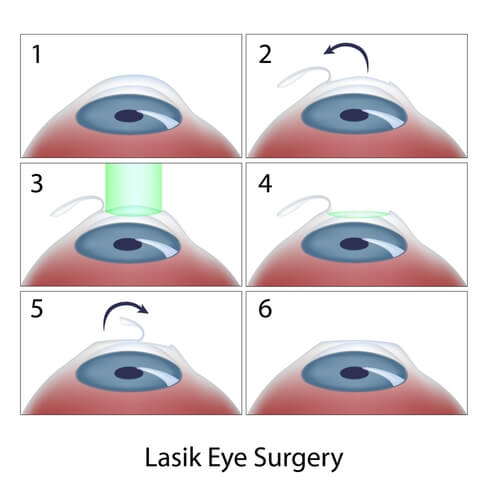What is the Difference Between LASIK and PRK?
December 4, 2023
If you have been thinking about permanently correcting your vision, the first thing that you may have thought about is LASIK. However, if you have certain eye conditions, you may be told you are not a good candidate for LASIK.
If your eye doctor determines that LASIK is not right for you, they may suggest another procedure to help you achieve the crisp, clear vision you want. Keep reading to learn what the difference is between LASIK and PRK!
What is LASIK?
 LASIK stands for Laser-Assisted In Situ Keratomileusis. It is a vision-correcting laser refractive procedure that can effectively correct refractive errors, including nearsightedness, farsightedness, and astigmatism, which is an irregularity in the shape of the eye.
LASIK stands for Laser-Assisted In Situ Keratomileusis. It is a vision-correcting laser refractive procedure that can effectively correct refractive errors, including nearsightedness, farsightedness, and astigmatism, which is an irregularity in the shape of the eye.
LASIK is the foremost vision-correction procedure performed by eye surgeons today. There are approximately 800,000 LASIK procedures performed each year in the US alone.
It also has high levels of success. 90% of all LASIK patients end up with 20/20 vision or better. These patients no longer need to rely on visual aids like glasses and contact lenses, allowing them to achieve visual freedom.
LASIK is an outpatient procedure performed at Eyes of York. It only takes about 10 minutes per eye. After it's over, you'll need a friend or family member to drive you home, as your vision will still be unstable due to the numbing eye drops.
Ready for LASIK?
Find out if you’re a candidate.
Who is a Good Candidate for LASIK?
Before you can undergo LASIK at Eyes of York, you'll need to schedule a consultation. During the consultation, you'll have a comprehensive examination of your eyes to determine whether you are a good candidate. You may be a good candidate for LASIK if:
- You are at least 18 years old
- Your prescription is stable and has remained unchanged for a year or more
- Your prescription is within the range that LASIK can treat
- Your eyes are healthy without a history of any serious eye conditions
- You are in good health
- You have realistic expectations about what LASIK can achieve
What Happens During LASIK?
During the LASIK procedure at Eyes of York, your LASIK surgeon will begin by numbing your eyes with special eye drops. Once your eyes are numb, they will use a precise femtosecond laser to create a tiny flap on the surface of your cornea, which is the clear outer layer at the front of your eye.
Your LASIK surgeon will then use an excimer laser to reshape the cornea. Reshaping the cornea helps correct any refractive errors that keep you from seeing clearly. Then, they'll finish the procedure by replacing the flap to facilitate healing post-LASIK. There are no stitches or sutures used since the flap acts as a natural bandage.
After LASIK
 Following your procedure, you should take a day to rest and recover. It's normal to experience some post-procedure discomfort, like itchiness, tearing, and redness. However, these symptoms usually clear up within a day or two.
Following your procedure, you should take a day to rest and recover. It's normal to experience some post-procedure discomfort, like itchiness, tearing, and redness. However, these symptoms usually clear up within a day or two.
Most people find they are ready to resume their normal routines with greatly improved vision a day or so after LASIK. Many people even notice vast visual improvements almost immediately after LASIK.
Your eyes should fully heal after LASIK after about three months. Peak vision occurs about six months after the procedure.
Learn More About LASIK
Schedule a Free LASIK Consultation!
What is PRK?
PRK, which stands for photorefractive keratectomy, is another vision-correcting procedure. Like LASIK, PRK can correct refractive errors like nearsightedness, farsightedness, and astigmatism. PRK was the first vision correction procedure. It also provides virtually identical results to LASIK.
PRK can be a good option for patients with certain eye conditions preventing them from qualifying for LASIK. If you have thin corneas or have been diagnosed with dry eye syndrome, LASIK might not be right for you. However, PRK may be a viable alternative.
After the procedure, 90% of PRK patients report 20/40 vision or better without needing to rely on glasses or contact lenses. In some cases, PRK can completely eliminate the need for visual aids, allowing them to see clearly.
Who is a Good Candidate for PRK?
Like LASIK, you cannot undergo PRK without a consultation. If you are a good fit for the procedure, the next step will be scheduling it.
Although PRK can be a suitable alternative to LASIK, if you meet any of the following factors, you may not be a good candidate for PRK. These include:
- Having an unstable refractive error
- Corneal scarring or disease
- Advanced glaucoma or developing cataracts
- Unmanaged diabetes
- A history of certain eye infections
What Happens During PRK?
Your surgeon begins PRK by numbing your eyes to ensure you’re comfortable during the procedure. They will then use an excimer laser to remove the outer layer of cells on your cornea, called the epithelium.
After removing the epithelium, they will use the excimer laser to reshape your cornea and correct your refractive errors. PRK concludes with your surgeon placing a special contact lens “bandage” over your eye to protect the exposed cornea.
Even with this bandage, it is important to carefully follow your eye doctor’s post-surgery instructions to prevent infection and promote healing.
After PRK
The recovery period after PRK is longer than LASIK’s recovery. This is largely because it takes time for the epithelium to regrow.
You may experience some discomfort as well, but this can be managed with prescription or over-the-counter eye drops or medications. While your vision may be blurry for a day or so following PRK, as your eyes heal, your vision will gradually improve over time.
Most PRK patients say that they were able to enjoy improved vision within 2-4 weeks following their procedure.
How Do LASIK and PRK Differ?
 While both of these procedures use a laser to reshape the cornea, the biggest difference between the two is the method used to access the cornea itself. In LASIK, a small flap is created, and in PRK, the epithelium is removed.
While both of these procedures use a laser to reshape the cornea, the biggest difference between the two is the method used to access the cornea itself. In LASIK, a small flap is created, and in PRK, the epithelium is removed.
There is no flap created during PRK, making it an excellent choice for patients with dry eyes or thinner corneas. Another difference between the two is who qualifies as a candidate for these procedures.
LASIK is right for many people, but it is not a safe or effective procedure for people with dry eye syndrome or thin corneas. PRK can give people with these eye conditions an effective alternative for meeting their visual goals.
While PRK can mean longer recovery times, it provides patients with virtually identical vision.
If you don’t qualify for LASIK, it doesn’t mean you have to give up on your vision goals! With alternative options like PRK, you can enjoy seeing the world with crisp, clear sight, free from visual aids.
Find out if you could be a good candidate for a vision correction procedure by scheduling a laser vision correction screening at Eyes of York in York, PA, now! Why wait any longer for better vision?



